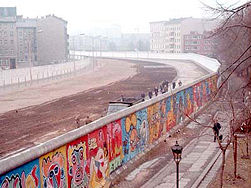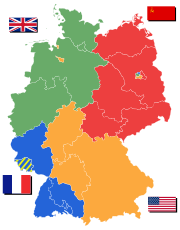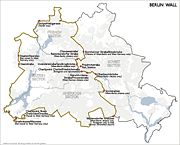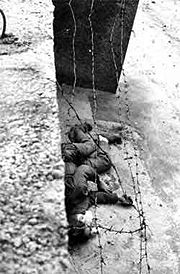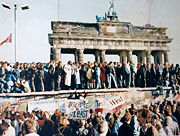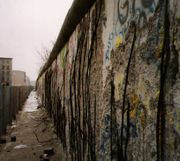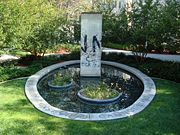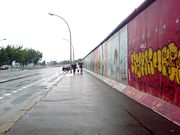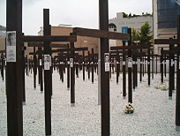Berlin Wall
2008/9 Schools Wikipedia Selection. Related subjects: Recent History
The Berlin Wall (German: Berliner Mauer) was a barrier separating West Berlin from East Berlin and the rest of East Germany. The longer ' inner German border' demarcated the remainder of the East-West German border between the two states. Both borders were part of the Iron Curtain.
The wall separated East Berlin and West Berlin for 28 years, from the day construction began on August 13, 1961 until it was dismantled in 1989, and was considered to be a longtime symbol of the Iron Curtain. During this period, at least 133 people were confirmed killed trying to cross the Wall into West Berlin, according to official figures. However, a prominent victims' group claims that more than 200 people had been killed trying to flee from East to West Berlin. The GDR/East German government gave shooting orders to border guards dealing with defectors; such orders are not the same as shoot to kill orders which GDR officials have denied exist.
When the East German government announced on November 9, 1989, after several weeks of civil unrest, that visits in West Germany and West Berlin would be permitted, crowds of East Germans climbed onto and crossed the wall, joined by West Germans on the other side in a celebratory atmosphere. Over the next few weeks, parts of the wall were chipped away by a euphoric public and by souvenir hunters; industrial equipment was later used to remove almost all of the rest of it.
The fall of the Berlin Wall paved the way for German reunification, which was formally concluded on October 3, 1990.
Background
After the end of World War II in Europe, what territorially remained of Nazi Germany was divided into four occupation zones (per the Potsdam Agreement), each one controlled by one of the four occupying Allied powers: the Americans, British, French and Soviets. The old capital of Berlin, as the seat of the Allied Control Council, was similarly subdivided into four sectors despite the city lying deep inside the zone of the Soviet Union. Although the intent was for the occupying powers to govern Germany together inside the 1947 borders, the advent of Cold War tension caused the French, British and American zones to be formed into the Federal Republic of Germany (and West Berlin) in 1949, excluding the Soviet zone, which then formed the German Democratic Republic (including East Berlin).
Divergence of German states
West Germany developed into a western capitalist country with a social market economy ("Soziale Marktwirtschaft" in German) and a democratic parliamentary government. Continual economic growth starting in the 1950s fuelled a 30-year " economic miracle" ("Wirtschaftswunder"). Across the inner-German border, East Germany established an authoritarian government with a Soviet-style planned economy. While West Germany became rich, many East Germans wanted to move to West Germany. The East Germans constructed the Berlin Wall to stop East Germans from fleeing. However, East German soldiers allowed West Berliners to cross into East Germany.
Barrier between East and West Germany
On 1 April 1952, East German leaders met the Soviet leader Stalin in Moscow; during the discussions Stalin's foreign minister Vyacheslav Molotov proposed that the East Germans should "introduce a system of passes for visits of West Berlin residents to the territory of East Berlin [so as to stop] free movement of Western agents" in the GDR. Stalin agreed, calling the situation "intolerable". He advised the East Germans to build up their border defenses, telling them that "The demarcation line between East and West Germany should be considered a border – and not just any border, but a dangerous one ... The Germans will guard the line of defense with their lives."
Consequently, the border between East and West Germany was closed, and a barbed-wire fence erected. The border between East and West Berlin, however, remained open, although traffic between the Eastern and the Western sectors was somewhat restricted.
Construction begins, 1961

On June 15, 1961, two months before the construction of the Berlin Wall started, First Secretary of the Socialist Unity Party and Staatsrat chairman Walter Ulbricht stated in an international press conference, "Niemand hat die Absicht, eine Mauer zu errichten!" (No one has the intention to erect a wall). It was the first time the colloquial term Mauer (wall) had been used in this context.
On Saturday August 12, 1961, the leaders of East Germany attended a garden party at a government guesthouse in Döllnsee, in a wooded area to the north of East Berlin, and Walter Ulbricht signed the order to close the border and erect a Wall.
At midnight the army, police, and units of the East German army began to close the border and by morning on Sunday August 13, 1961 the border to West Berlin had been shut. East German troops and workers had begun to tear up streets running alongside the barrier to make them impassable to most vehicles, and to install barbed wire entanglements and fences along the 156 km (97 miles) around the three western sectors and the 43 km (27 miles) which actually divided West and East Berlin. The Soviets were not directly involved.
The barrier was built slightly inside East German territory to ensure that it did not encroach on West Berlin at any point, and was later built up into the Wall proper, the first concrete elements and large blocks being put in place on August 15. During the construction of the Wall, NVA and KdA soldiers stood in front of it with orders to shoot anyone who attempted to defect. Additionally, the whole length of the border between East and West Germany was closed with chain fences, walls, minefields, and other installations.
Secondary response
It was clear both that West German morale needed lifting and that there was a serious potential threat to the viability of West Berlin. If West Berlin fell after all the efforts of the Berlin Airlift, how could any of America's other allies rely on it? On the other hand, in the face of any serious Soviet threat, an enclave like West Berlin could not be defended except with nuclear weapons. As such, it was vitally important for the Americans to show the Soviets a display of strength and also placate West German and French pressure for a more serious response.
Accordingly, General Lucius D. Clay, an anti-communist who was known to have a firm attitude towards the Soviets, was sent to Berlin with ambassadorial rank as Kennedy's special advisor. He and Vice President Lyndon B. Johnson arrived at Tempelhof Airport on the afternoon of Saturday August 19.
They arrived in a city defended by what would soon be known as the " Berlin Brigade", which then consisted of the 2nd and 3rd Battle Groups of the 6th Infantry, with Company F, 40th Armor. The battle groups were "pentatomic" (A flatter command structure with five battle groups instead of the old three regiments with three battalions and were also equipped with tactical nuclear weapons), with 1,362 officers and men each. On August 16, Kennedy had given the order for them to be reinforced. Early on August 19, the 1st Battle Group, 18th Infantry (commanded by Col. Glover S. Johns Jr.) was alerted.
On Sunday morning, lead elements arranged in a column of 491 vehicles and trailers carrying 1,500 men divided into five march units and left the Helmstedt-Marienborn checkpoint at 06:34. At Marienborn, the Soviet checkpoint next to Helmstedt on the West German/East German border, U.S. personnel were counted by guards. The column was 160 km (~100 miles) long, and covered 177 km (~110 miles) from Marienborn to Berlin in full battle gear, with VoPos (East German police) watching from beside trees next to the autobahn all the way along. The front of the convoy arrived at the outskirts of Berlin just before noon, to be met by Clay and Johnson, before parading through the streets of Berlin to an adoring crowd. At 04:00 on August 21, Lyndon Johnson left a visibly reassured West Berlin in the hands of Gen. Frederick O. Hartel and his brigade of 4,224 officers and men. Every three months for the next three and a half years, a new American battalion was rotated into West Berlin by autobahn to demonstrate Allied rights.
The creation of the Wall had important implications for both German states. By stemming the exodus of people from East Germany, the East German government was able to reassert its control over the country: in spite of discontent with the wall, economic problems caused by dual currency and the black market were largely eliminated, and the economy in the east grew. However, the Wall proved a propaganda disaster for the communist bloc as a whole. Western powers used it as a symbol of communist tyranny, particularly after the shootings of would-be defectors (which were later treated as acts of murder by the reunified Germany). In 1987, Ronald Reagan gave a famous speech at the Brandenburg Gate, at which he challenged Mikhail Gorbachev to " tear down this wall". In West Germany, dismay that the Western powers had done nothing to prevent the Wall's creation led directly to the policy of Ostpolitik or rapprochement with the east, in an effort to stabilize the relationship of the two German states.
Layout and modifications
The Wall was over 155 kilometers (96 mi) long. In June 1962, work started on a second parallel fence up to 91 meters (100 yd) further into East German territory, with houses in between the fences torn down and their inhabitants relocated. A no man's land was created between the two barriers, which became widely known as the "death strip". It was paved with raked gravel, making it easy to spot footprints; it offered no cover; it was booby-trapped with tripwires; and, most importantly, it offered a clear field of fire to the watching guards. Over the years, the Wall went through four distinct phases:
- Basic wire fence (1961)
- Improved wire fence (1962–1965)
- Concrete wall (1965–1975)
- Grenzmauer 75 (Border Wall 75) (1975–1989)
The "fourth-generation wall", known officially as "Stützwandelement UL 12.11" (retaining wall element UL 12.11), was the final and most sophisticated version of the Wall. Begun in 1975 and completed about 1980, it was constructed from 45,000 separate sections of reinforced concrete, each 3.6 meters (12 ft) high and 1.2 meters (4 ft) wide, and cost 16,155,000 East German Marks or about 3,638,000 United States Dollars. The top of the wall was lined with a smooth pipe, intended to make it more difficult to scale. It was reinforced by mesh fencing, signal fencing, anti-vehicle trenches, barbed wire, dogs on long lines, " fakir beds" under balconies hanging over the "death strip", over 116 watchtowers, and 20 bunkers. This version of the Wall is the one most commonly seen in photographs, and surviving fragments of the Wall in Berlin and elsewhere around the world are generally pieces of the fourth-generation Wall. The layout came to resemble the Inner German border in most technical aspects, except the Berlin Wall had no landmines and no Spring-guns.
Official crossings and usage
There were eight border crossings between East and West Berlin, allowing visits by West Berliners, West Germans, western foreigners and Allied personnel into East Berlin, as well as visits of East German citizens into West Berlin, provided they held the necessary permit. Those crossings were restricted according to which nationality was allowed to use it (East Germans, West Germans, West Berliners, other countries). The most famous was Friedrichstraße ( Checkpoint Charlie), which was restricted to Allied personnel and non-German citizens.
Several other border crossings existed between West Berlin and surrounding East Germany. These could be used for transit between West Germany and West Berlin, for visits by West Berliners into East Germany, for transit into countries neighbouring East Germany (Poland, Czechoslovakia, Denmark), and for visits by East Germans into West Berlin carrying a permit. After the 1972 agreements, new crossings were opened to allow West Berlin waste to be transported into East German dumps, as well as some crossings for access to West Berlin's exclaves (see Steinstücken).
Four motorways usable by West Germans connected West Berlin to West Germany, the most famous being Berlin-Helmstedt autobahn, which entered East German territory at the town of Helmstedt (Checkpoint Alpha) and connected to Berlin at Dreilinden (Checkpoint Bravo) in south-western Berlin. Access to West Berlin was also possible by railway (four routes) and by boat using canals and rivers.
Westerners could cross the border at Friedrichstraße station in East Berlin and at Checkpoint Charlie. When the Wall was erected, Berlin's complex public transit networks, the S-Bahn and U-Bahn, were divided with it. Some lines were cut in half; many stations were shut down. Three Western lines traveled through brief sections of East Berlin territory, passing through eastern stations (called Geisterbahnhöfe, or ghost stations) without stopping. Both the eastern and western networks converged at Friedrichstraße, which became a major crossing point for those (mostly Westerners) with permission to cross.
Who could cross
West Germans and citizens of other Western countries could in general visit East Germany. Usually this involved application of a visa at an East German embassy several weeks in advance. Visas for day trips restricted to East Berlin were issued without previous application in a simplified procedure at the border crossing. However East German authorities could refuse entry permit without stating a reason.
West Berliners could at first not visit East Berlin or East Germany at all. All crossing points were closed to them between August 26, 1961 and December 17, 1963. In 1963 negotiations between East and West resulted a limited possibility for visits at Christmas that year ("Passierscheinregelung"). Similar very limited arrangements were made in 1964, 1965 and 1966.
In 1971 with the Four Power Agreement on Berlin, agreements were reached that allowed West Berliners to apply for visas for East Berlin and East Germany regularly, comparable to the regulations already in force for West Germans. East German authorities could still refuse entry permits.
East Berliners and East Germans could at first not travel to West Berlin or West Germany at all. This regulation remained in force basically until the fall of the wall, but over the years several exceptions to these rules were introduced. The most significant being:
- Old age pensioners could travel to the west starting in 1964
- Visits of relatives for important family matters
- People who had to travel to the west for professional reasons (e.g. artists, lorry drivers etc.)
However each visit had to be applied for individually and the permission was never guaranteed.
Citizens of other East European countries were in general subject to the same prohibition to visit western countries as East Germans, even though there was variation in the applicable exception (if any) from country to country.
Allied military personnel, officials, and diplomats were able to pass into East Berlin without passport check; likewise Soviet patrols could pass into West Berlin. This was a requirement of the post-war Four Powers Agreements.
Escape attempts
During the Wall's existence there were around 5,000 successful escapes into West Berlin. The number of people who died trying to cross the wall or as a result of the wall's existence has been controversial. The most vocal claims by Alexandra Hildebrandt, Director of the Checkpoint Charlie Museum and widow of the Museum's founder estimated the death toll to be well above 200 people while an ongoing historic research group at the Centre for Contemporary Historical Research ( ZZF) in Potsdam has confirmed 133 deaths. Guards were told by East German authorities that people attempting to cross the wall were criminals and needed to be shot: "Do not hesitate to use your firearm, not even when the border is breached in the company of women and children, which is a tactic the traitors have often used," they said.
Early successful escapes involved people jumping the initial barbed wire or leaping out of apartment windows along the line but these ended as the wall was fortified. In order to solve these simple escape attempts, East German authorities no longer permitted Apartments near the wall to be occupied and any building near the wall had to have their windows boarded up. On August 15, 1961, Conrad Schumann was the first East German border guard to escape by jumping the barbed wire to West Berlin. Later successful escape attempts included long tunnels, waiting for favorable winds and taking a hot air balloon, sliding along aerial wires, flying ultralights, and in one instance, simply driving a sports car at full speed through the basic, initial fortifications. When a metal beam was placed at checkpoints to prevent this kind of escape, up to four people (two in the front seats and possibly two in the boot) drove under the bar in a sports car that had been modified to allow the roof and wind screen to come away when it made contact with the beam. They simply lay flat and kept driving forward. This issue was rectified with zig-zagging roads at checkpoints.
Another airborne escape was by Thomas Krüger, who landed a Zlin Z-42M light aircraft of the Gesellschaft für Sport und Technik, an East German youth military training organization, at RAF Gatow. His aircraft, registration DDR-WOH, was dismantled and returned to the East Germans by road, complete with humorous slogans painted on by RAF Airmen such as "Wish you were here" and "Come back soon". DDR-WOH is still flying today, but under the registration D-EWOH.
If an escapee was wounded in a crossing attempt and lay on the death strip, no matter how close they were to the Western wall, they could not be rescued for fear of triggering engaging fire from the 'Grepos', the East Berlin border guards. The guards often let fugitives bleed to death in the middle of this ground, like in the most notorious failed attempt, that of Peter Fechter (aged 18). He was shot and bled to death in full view of the western media, on August 17, 1962. The last person to be killed while trying to cross the border was Chris Gueffroy on February 6, 1989.
The Fall, 1989

On August 23, 1989, communist Hungary removed its border restrictions with Austria, and in September more than 13,000 East German tourists in Hungary escaped to Austria. Mass demonstrations against the government in East Germany began in October 1989. The long-time leader of East Germany, Erich Honecker, resigned on October 18, 1989, and was replaced by Egon Krenz a few days later. Honecker had predicted in January of that year that the wall would stand for a "hundred more years" if the conditions which had caused its construction did not change.
Protest demonstrations broke out all over East Germany in September 1989. Initially, they were of people wanting to leave to the West, chanting "Wir wollen raus!" ("We want out!"). Then protestors began to chant "Wir bleiben hier", ("We're staying here!"). This was the start of what East Germans generally call the "Peaceful Revolution" of late 1989. The protestors wanted to create " socialism with a human face," and by November 4, 1989, the protests had swelled significantly, with a million people gathered that day in Alexanderplatz in East Berlin.
Meanwhile the wave of refugees leaving East Germany for the West had increased and had found its way through Czechoslovakia, tolerated by the new Krenz government and in agreement with the communist Czechoslovak government. In order to ease the complications, the politburo led by Krenz decided on November 9, 1989, to allow refugees to exit directly through crossing points between East Germany and West Germany, including West Berlin. On the same day, the ministerial administration modified the proposal to include private travel. The new regulations were to take effect on November 10. Günter Schabowski, the East German Minister of Propaganda, had the task of announcing this; however he had been on vacation prior to this decision and had not been fully updated. Shortly before a press conference on November 9, 1989, he was handed a note that said that East Berliners would be allowed to cross the border with proper permission but given no further instructions on how to handle the information. These regulations had only been completed a few hours earlier and were to take effect the following day, so as to allow time to inform the border guards. However, nobody had informed Schabowski. He read the note out loud at the end of the conference and when asked when the regulations would come into effect, he assumed it would be the same day based on the wording of the note and replied "As far as I know effective immediately, without delay". After further questions from journalists he confirmed that the regulations included the border crossings towards West Berlin, which he had not mentioned until then.
Tens of thousands of East Berliners heard Schabowski's statement live on East German television and flooded the checkpoints in the Wall demanding entry into West Berlin. The surprised and overwhelmed border guards made many hectic telephone calls to their superiors, but it became clear that there was no one among the East German authorities who would dare to take personal responsibility for issuing orders to use lethal force, so there was no way for the vastly outnumbered soldiers to hold back the huge crowd of East German citizens. In face of the growing crowd, the guards finally yielded, opening the checkpoints and allowing people through with little or no identity checking. Ecstatic East Berliners were soon greeted by West Berliners on the other side in a celebratory atmosphere. November 9 is thus considered the date the Wall fell. In the days and weeks that followed, people came to the wall with sledgehammers in order to chip off souvenirs, demolishing lengthy parts of it in the process. These people were nicknamed "Mauerspechte" (wall woodpeckers).
The East German regime announced the opening of ten new border crossings the following weekend, including some in symbolic locations ( Potsdamer Platz, Glienicker Brücke, Bernauer Straße). Crowds on both sides waited there for hours, cheering at the bulldozers who took parts of the Wall away to reinstate old roads. Photos and television footage of these events is sometimes mislabelled "dismantling of the Wall", even though it was merely the construction of new crossings. New border crossings continued to be opened through summer 1990, including the Brandenburg Gate on December 22, 1989.
West Germans and West Berliners were allowed visa-free travel starting December 23, 1989. Until then they could only visit East Germany and East Berlin under restrictive conditions that involved application for a visa several days or weeks in advance, and obligatory exchange of at least 25 DM per day of their planned stay, all of which hindered spontaneous visits. Thus, in the weeks between November 9 and December 23, East Germans could travel "more freely" than Westerners.
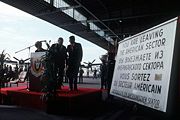
Technically the Wall remained guarded for some time after November 9, though at a decreasing intensity. In the first months, the East German military even tried to repair some of the damages done by the "wall peckers". Gradually these attempts ceased, and guards became more lax, tolerating the increasing demolitions and "unauthorised" border crossing through the holes. On June 13, 1990, the official dismantling of the Wall by the East German military began in Bernauer Straße. On July 1, the day East Germany adopted the West German currency, all border controls ceased, although the inter-German border had become meaningless for some time before that. The dismantling continued to be carried out by military units (after unification under the Bundeswehr) and lasted until November 1991. Only a few short sections and watchtowers were left standing as memorials.
The fall of the Wall was the first step toward German reunification, which was formally concluded on October 3, 1990.
Celebrations
On December 25, 1989, Leonard Bernstein gave a concert in Berlin celebrating the end of the Wall, including Beethoven's 9th symphony ( Ode to Joy) with the word "Joy" (Freude) changed to "Freedom" (Freiheit) in the text sung. The orchestra and chorus were drawn from both East and West Germany, as well as the United Kingdom, France, the Soviet Union, and the United States.
Roger Waters performed the Pink Floyd album The Wall in Potsdamer Platz on 21 July 1990, with guests including Scorpions, Bryan Adams, Sinéad O'Connor, Thomas Dolby, Joni Mitchell, Marianne Faithfull and Van Morrison. David Hasselhoff performed his song "Looking for Freedom", which was very popular in Germany at that time, standing on the Berlin wall.
Some believe November 9 would have made a suitable German National Holiday, since it both marks the emotional apogee of East Germany's peaceful revolution and is also the date of the declaration of the first German republic, the Weimar Republic, in 1918. However, November 9 is also the anniversary of the 1923 Beer Hall Putsch and the infamous Kristallnacht pogroms of 1938 and, therefore, October 3 was chosen instead. Part of this decision was that the East German government wanted to conclude reunification before East Germany could celebrate a 41st anniversary on October 7, 1990.
Legacy
Little is left of the Wall at its original site, which was destroyed almost everywhere. Three long sections are still standing: an 80-meter (263 ft) piece of the "first (westernmost) wall" at the site of the former Gestapo headquarter half way between Checkpoint Charlie and Potsdamer Platz; a longer section of the "second (easternmost) wall" along the Spree River near the Oberbaumbrücke nicknamed East Side Gallery; and a third section with hints of the full installation, but partly reconstructed, in the north at Bernauer Straße, which was turned into a memorial in 1999. Some other isolated fragments and a few watchtowers also remain in various parts of the city. None still accurately represent the Wall's original appearance. They are badly damaged by souvenir seekers, and fragments of the Wall both with and without certificates of authenticity are a staple on the online auction service eBay as well as German souvenir shops. Moreover, the eastern side is covered in graffiti that did not exist while the Wall was guarded by the armed soldiers of East Germany. Previously, graffiti appeared only on the western side. Along the tourist areas of the city centre, the city government has marked the location of the former wall by a row of cobblestones in the street. In most places only the "first" wall is marked, except near Potsdamer Platz where the stretch of both walls is marked, giving visitors an impression of the dimension of the barrier system. Pieces of the wall were taken and sold around the world.
Museum
Fifteen years after the fall, a private museum rebuilt a 200-metre (656 ft) section close to Checkpoint Charlie, although not in the location of the original wall. They also raised more than 1,000 crosses in memory of those who died attempting to flee to the West. The memorial was installed in October 2004 and demolished in July 2005.
Cultural differences
Even now, some years after reunification, there is still talk in Germany of cultural differences between East and West Germans (colloquially Ossis and Wessis), sometimes described as "Mauer im Kopf" ("The wall in the head"). A September 2004 poll found that 25% of West Germans and 12% of East Germans wished that East Germany and West Germany were again cut off by the Berlin Wall.
